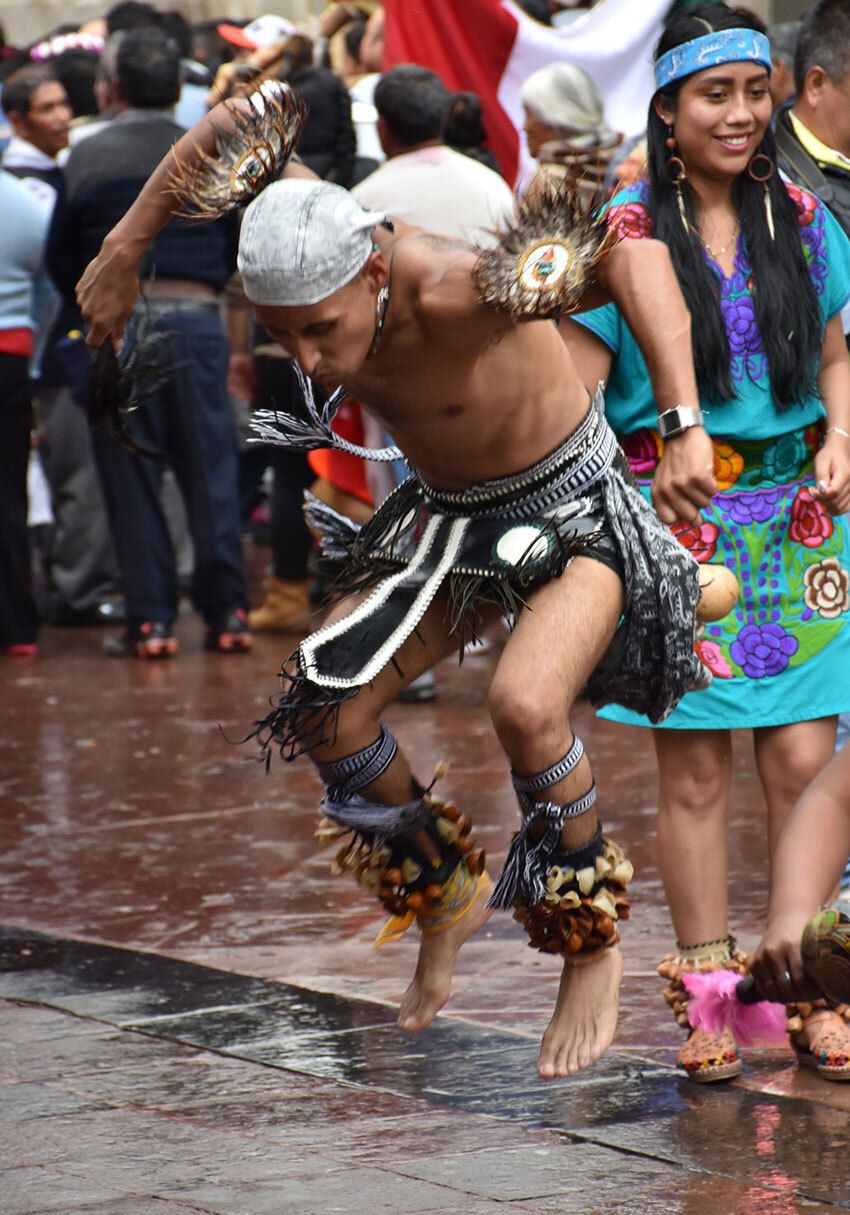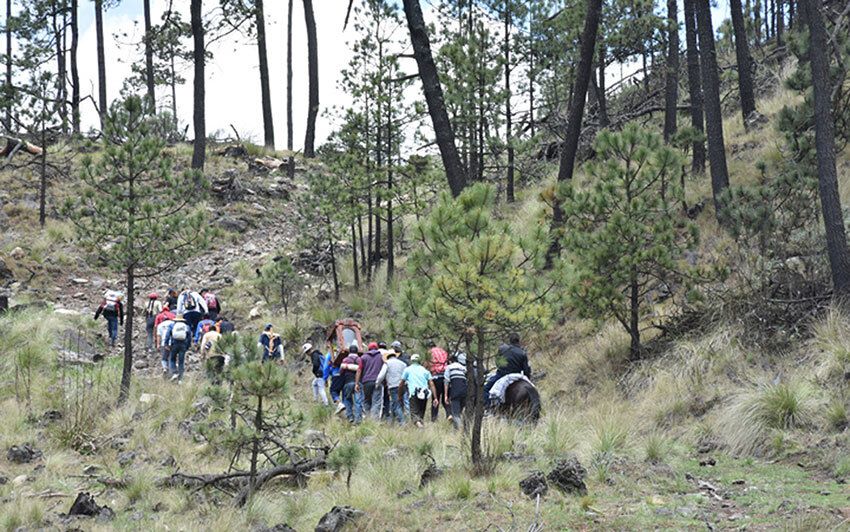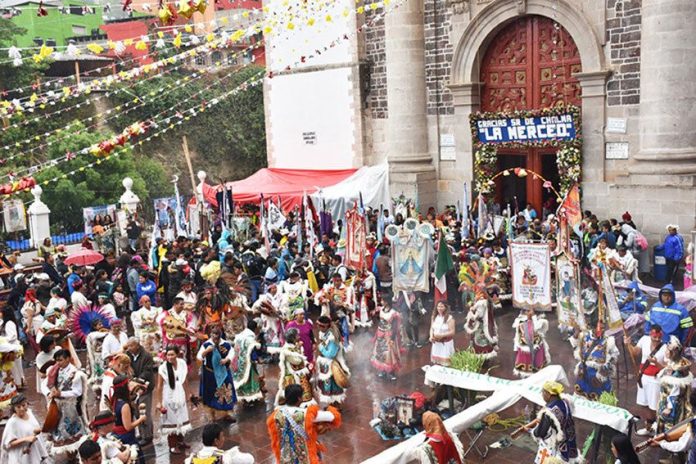Santiago was talking to me about the pilgrimage to Chalma when he became adamant about one thing.
“You must ride a horse,” he said.
I was born and raised on Staten Island, a borough of New York City, and my family didn’t have many opportunities for horseback riding. Actually, we had none. I told him it was a bad idea, but he kept insisting.
“You will be fine,” he said.
I had my doubts.
I was working on a book chronicling a year in San Gregorio Atlapulco, a town in Xochimilco, Mexico City, and that meant going on pilgrimages. Chalma, which is located in México state, is the second-most-important pilgrimage site in Mexico after the Villa Guadalupe.
“The pilgrimage is Catholic,” said Javier Márquez Juárez, who goes every year, “but it is also indigenous.”

The origin of the pilgrimage is this: one of the gods worshipped by the Mexicas was Tezcatlipoca, the Smoking Mirror or Dark Lord. There was a life-sized statue of the god in a cave in Chalma, and this didn’t sit well with the Augustinian friars who arrived around 1537, determined to convert indigenous communities to Christianity. According to one legend, two friars wanted the idol destroyed, and when it wasn’t, they went to the cave to destroy it themselves. However, when they arrived, they found the idol in pieces on the ground, replaced by a figure of a crucified black Christ. Mexicas supposedly converted on the spot.
Pilgrimages are held throughout the year.
“The largest pilgrimages are on New Year’s, Ash Wednesday and Good Friday,” said Márquez. “Ones that occur in May and June, like the one from San Gregorio Atlapulco, have pre-Hispanic elements. Those months are when indigenous groups petitioned for rain.”
Bowing to Santiago’s gentle, if persistent, pressure, to ride a horse, I figured I should take riding lessons. I told Max, my instructor, and an expert horseman, about Santiago’s insistence.
“Sometimes the trails are difficult even for us,” he said, which caused me no end of worry. But when I mentioned this to Javier he said, “You will be fine.”
Most from San Gregorio walk or ride horses to Chalma, a challenging two and a half days covering about 45 miles. There are steep climbs on narrow mountain paths, and because it’s the rainy season, there are often severe storms to contend with. Yet the pilgrims go every year.
“I go to show the faith I have in the Lord of Chalma,” said Juan Manzanares who has gone on the pilgrimage for 26 years, almost half his life. “To feel the peace and spirituality of the sanctuary, also … to conserve the traditions of our country.”
For Raúl Hernandez Serralde, the pilgrimage is a chance to give thanks for a perceived miracle. “When I was three, I was very sick, and the doctor did not know if I would live,” he said. “My grandfather carried me all the way to Chalma. He walked the whole way. He bathed me in the river there … and I did recover. It was a miracle. So I go to Chalma every year to give thanks to God.”
Underlying beliefs in indigenous religions and traditions also compel people to go.
“We go to ask for rain so that we have a good harvest,” said Márquez. “When we walk through the mountains — mountains represent water — it is to ensure rain.”
A little after 5:00 a.m. on June 1, thousands of people streamed out of San Gregorio on their way to Chalma. Fireworks exploded overhead. The pilgrimage had started.
I was relieved that I didn’t ride the horse from the very beginning. But I became less sanguine when the flat road we were on turned into steep mountain paths. As we climbed one particularly challenging stretch, Santiago turned to me several times worriedly.
“Do you want to rest?” he asked each time.
“No,” I panted. “I’ll rest when we get to the top.”

When I finally got there, I decided to take some photos before resting. As soon as I sat down, however, Santiago announced, “Vámonos.”
I eventually rode the horse for a mostly uneventful hour, deciding I’d had enough when we stopped for a break and, despite my whispering to the horse, “Whoa, whoa” (I don’t know the Spanish equivalent), she kept going around in small circles. Santiago kindly helped me down. The second day was a six-hour walking marathon during which I’d gotten separated from the group and walked the last hour alone in a punishing downpour. Whoever had petitioned the gods for rain had had their prayers answered.
Finally, after a challenging two days, I was completely soaked and tired, but I’d made it. About 60 of us slept in tents that were set up under a second very large tent, which is also where we ate. It rained almost every day, so the ground was muddy and it was hard to stay dry. But no one complained.
I then spent three days in Chalma, going to the church every day and often at night. More pilgrims arrived daily, and thousands crammed into the churchyard, where different Aztec groups danced, pounded out different rhythms and sang. Masses were held continuously inside the church, where the black Christ now hangs.
The return trip was arguably even more difficult. I rode the horse for four hours on the second day, over mountain paths that were narrow, slick with mud, and blocked in parts by boulders and fallen trees. It was way beyond my ability but, miraculously I didn’t fall. I wish I could say it was due to my superior skills, but it was due to my clinging to the saddle as if my life depended on it. Which it may have.
A huge storm also hit at the end of that day; I’m talking about a storm where you start thinking about building an ark and selecting animals. At one point, three of us reached an intersection where water was so deep and moving so rapidly, we couldn’t cross. We had to detour and jump over a narrow stream. We bedded down the final night in a rodeo arena, sleeping on ground covered with stones, making for a very uncomfortable night.
We finally made it back to San Gregorio in the early afternoon and were greeted at the entrance to the pueblo with bottle rockets, toritos (makeshift structures filled with fireworks and carried above a person’s shoulders), other fireworks and, of course, another big meal.
All in all, the trek to Chalma took about 16 hours. We crossed mountains and fields under a hot sun. We were rained on. We were exhausted. We suffered — but that’s part of the point.
“When a group suffers together, they become much closer,” said Hernández. “Suffering is part of spirituality. We suffer, we make a sacrifice, to show thanks to God, to show our faith. So we walk, we sleep on the ground.”
“Suffering in the Catholic religion is payment for sins,” says Márquez. “In pre-Hispanic traditions, it is an expression of stoicism. So in pilgrimages today, there are two visions: Catholic and pre-Hispanic.”
Immediately after the pilgrimage ended, I decided that going once was enough, that I only went to take photographs. Now I’m not so sure. I now know what to expect, and that might make it a little easier.
But with the pilgrimage canceled this year because of the coronavirus, I have a whole year to decide.
Joseph Sorrentino is a regular contributor to Mexico News Daily.
